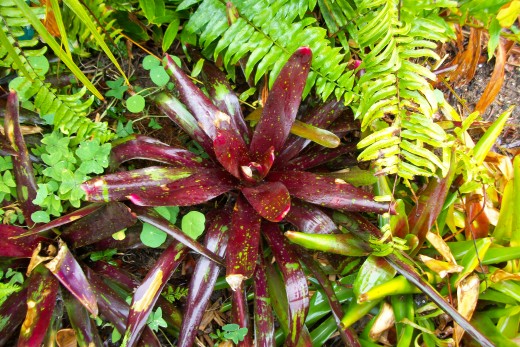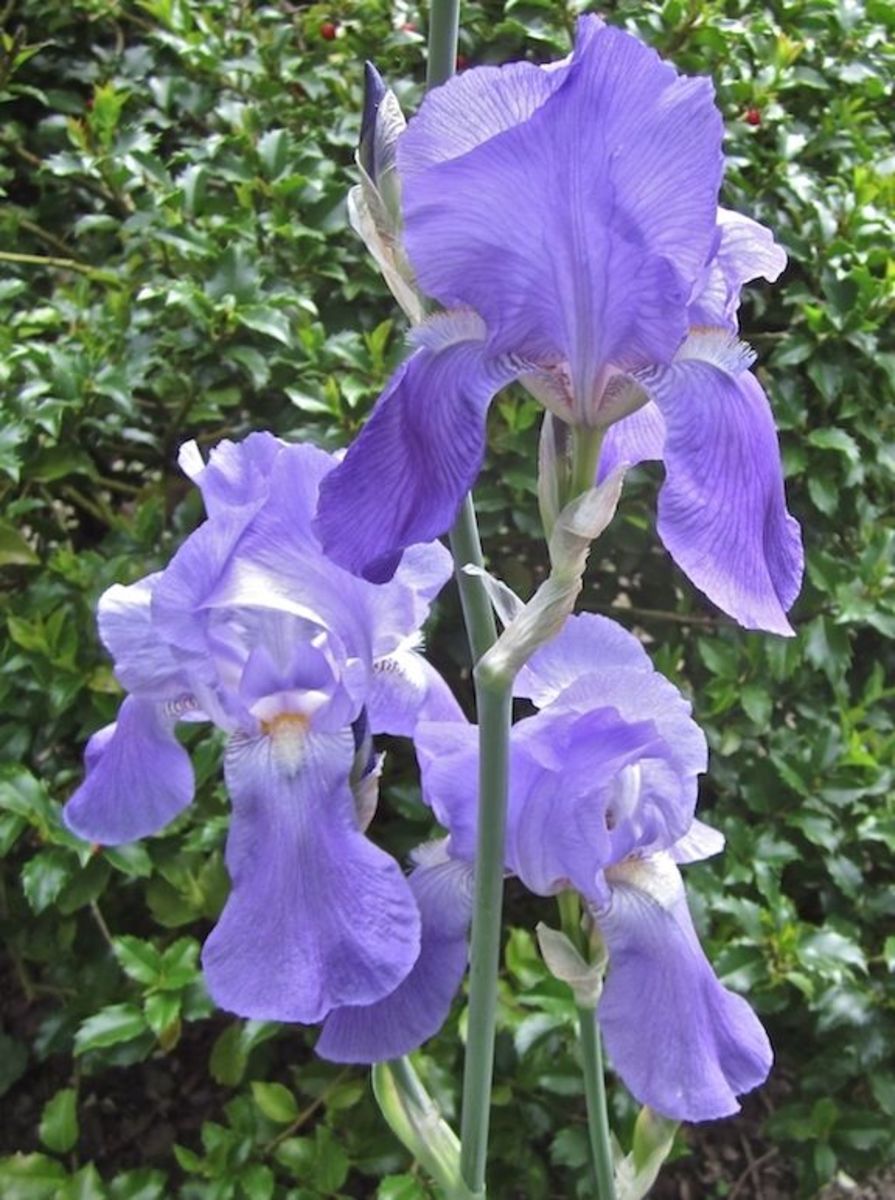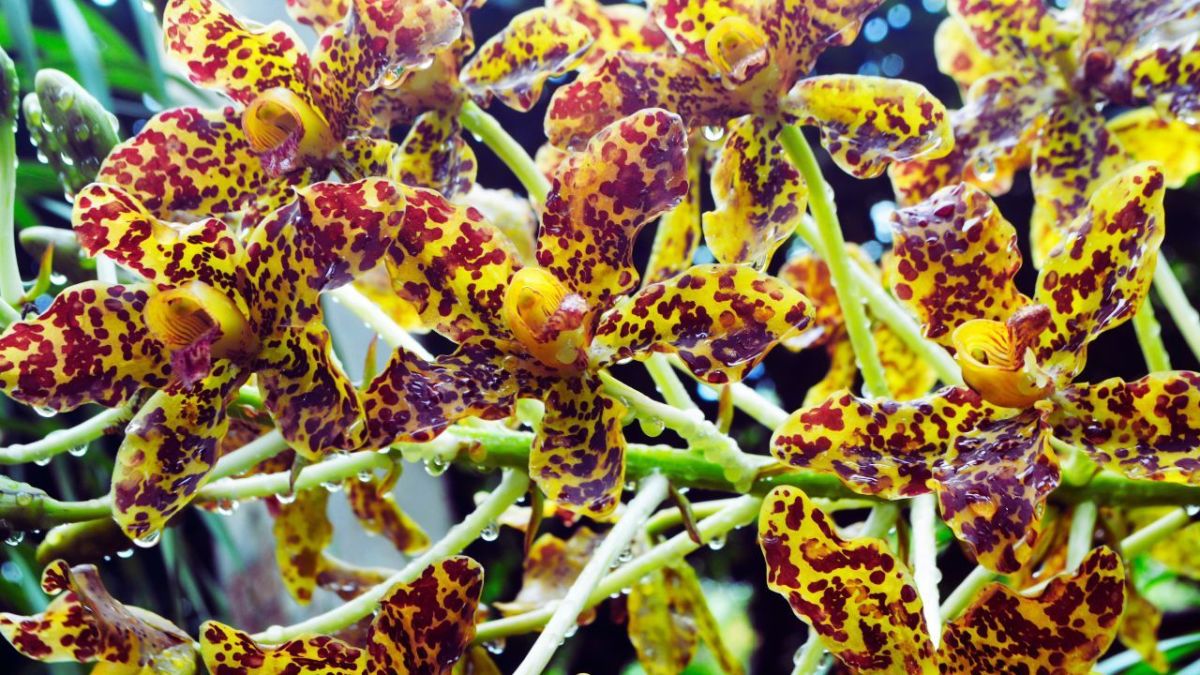Garbage In, Garden Out, The Recycling Gardener, Bones, Blood, Bananas and Baking Powder
I Know Flowers

Baking Powder for Flowers
Baking powders come in two types, fast acting and slow acting.
If you have the slow acting kind, it is made with sodium aluminum phosphate and/or sodium aluminum sulfate. In either case you are consuming aluminum, which, in my humble opinion, is toxic as it competes with calcium for absorption (and so reduces calcium absorption, something that is very important in the body), becomes deposited in the bone and central nervous system, but has no function anywhere in the body (the calcium it replaced does have a specific ionic function in the nervous system). Some researchers think it is associated with an increase in breast cancer and Alzheimer’s Disease, but this link is not proved, but why take the chance?
What is proved is that at high dosages it is a neurotoxin, and stresses the kidneys.
A better use for this is as a fertilizer for hydrangeas, in particular and other flowering plants in general.
Why Hydrangea? Aluminum added to hydrangea soil causes them to add a blue pigment to the flower. Now, there is a white variety that doesn’t change, but in general, aluminum turns the colored varieties a delightful blue color or, when iron is added also, the colors can be mixed or blended.
Other plants can use the aluminum also, it does have uses in plants, but not animals.
Both fast and slow varieties of baking soda have an acid reaction that produces our old friend CO2. This is what causes your cake to rise, it is what makes it light and fluffy, so the slow variety, Disodium dihydrogen pyrophosphate or Sodium acid pyrophosphate, often with monocalcium phosphate added is a good source of acid for the soils, but also adds phosphates which enhance blooms.
Simply because of the cost, I don’t recommend this as a regular fertilizer, but, say, you spill it on the floor and don’t know what to do with it, simply spread it around the flower bed.
Here is another principle: If you have a variety of different types of chemical compounds in the soil, in this case, two types of phosphorus, but other also exist there and, say, you have added bone meal, and compost, then different phosphates will be used at different times in the soil and, for different purposes. So, again, the organic complex is important for a slower release of nutrients.
How about for a pond? If you have a pond with water lilies (please make sure there are fish to eat mosquito larvae) this second, fast kind, that without the aluminum, can be added to the pond as well and will help water lilies bloom as well.
That reminds me, I need to go sprinkle some around my Martha Washington Geraniums!
Cream of Tartar for the Soil?
We really don’t pay much attention to what is in the cupboard.
Cream of Tartar is actually potassium hydrogen tartrate or potassium bitartrate, and is very much three organic acids and a potassium molecule, perhaps a spare carbon left over.
Again, because of the expense of the food grade product, only use this on house plants, but add just a sprinkle to the water you use, put the houseplant into a bowl and water the plant. By recovering the water you can use it over and over.
This will help neutralize alkali in the soil built up from other watering and help make the calcium from your normal tap water more available to the plant. While you are at it, add a sprinkle of baking powder, not baking soda (too much sodium).
Last, it adds potassium. The baking power adds phosphorus which causes plants to bloom and ferns to multiply.
Staghorn Ferns love bananas




Bananas
I love stag horn ferns. Stag horn ferns love bananas.
Anything that has protein has some nitrogen. There is nitrogen in the protein themselves and when bacteria or fungi break down the proteins into amino acids, another nitrogen atom is added.
Bananas are a high protein food as far as fruits are concerned.
Epiphytes are plants that grow on top of other plants but do not feed off of them. Stag horn ferns, some other ferns like the exotic Drynaria, and other plants like Tillandsia and some other bromeliads all get their nutrients primarily from things that fall into the plant from above.
Bananas and banana peels can be an important nutrient source for these plants. Overripe bananas are great for this, but before they get over ripe, try pealing them and freezing the fruit in plastic wrap. Then add to the blender with a little milk to make an incredible drink.
Failing that, your garden will happily accept any banana donations.
If you have a rabbit, make sure it doesn’t know where the banana is, they will eat banana to the exclusion of all other foods until they are quite sick. It is high volumes of banana that make it sick, not a small piece. A small piece of banana makes a rabbit your friend for life, or at least as long as you have the banana.
Why, I don’t know, but it is true.
Do you keep bromeliads? Try dropping a small piece of banana skin into the water bowl at the center of the plant when you water it. This will slowly deteriorate and feed the plant as it does so. Many Bromeliads prefer to be dry throughout most of the winter for the best color displays, so are rarely watered, but when you do they can use the nutrients in the banana skin, but especially through the summer.
Blood On the Saddle, Blood on the Ground. . .
Do you remember that old Disney song from the Bear Country Jamboree? The heavy set old cowboy bear with an undersized guitar or mandolin, strumming slowly, “There was blood on the saddle, blood on the ground.” He kept being cut off by the other bears, very cute.
I have to confess to not being perfect, though this might be more than obvious to those who know me. This morning I was out making much by trimming a large vine and snipping it into small pieces when suddenly a sharp pain went through my right ring finger tip. The pain was, of course, the plant sheers, which decided I needed to donate a bit of my blood to a rare plants nearby.
Ouch!
It really wasn’t that bad, but bleed it did and I let it bleed for a few seconds to wash out the wound before treating it.
That blood went onto a small potted plant, I made sure of that. But this isn’t the only blood my plants get, when blood drips out of meat, I will often catch it in a cup and throw it into a favorite potted plant. Blood meal is a regular we buy from the nursery.
Why, you ask?
Blood is a high nitrogen fertilizer, though I recommend buying it in the dried form as opposed to using your own. Even better, is some animal product pooling a little blood inside the wrapper before use? Try draining that into a glass, dilute it a little then pour it onto your plants. It provides much needed nitrogen and iron in the very useful heme form of iron. This is easy for microorganisms to take up and convert into iron the plant can absorb.
Blood meal is an excellent source of nitrogen and iron for your plants. I don’t know any plant, even the sensitive maidenhair ferns that don’t like this form of nitrogen. Hit this ferns with high nitrogen fertilizer and you may find yourself with a dead plant, but organic nitrogen releases slowly. They are really very complex proteins that slowly degrade into the soil.
No Bones About It
Well, we have drained our food of the blood in it to put into the garden, much better than eating it, but what about the bones? Bones and ever so slowly to the nitrogen in the garden, really so slowly it isn’t worth mentioning, but that add calcium phosphate. Bones has a big mixture of lots of different kinds of calcium phosphates all of which break down slowly in the soil. Bones can be added to the soils whole, in parts, or ground, cooked or raw, bones improve the soil.
Now, mind you, a bone is going to break down into the soil over dozens of years or hundreds of years according to how large it is and how cooked it is. Cooked bone breaks down more rapidly, but this is not to say they are fast decomposers, they are not, remember, dogs bury bones because they can come back later and find them, so don’t expect to dig the same spot and have it bone free in the years to come unless you crush it into small pieces or, even better, into powder. But if you follow other advice here and dig holes to bury garbage, bones make a great addition to deeper holes and help aerate the soil.
Boric Acid
Boric acid for ants & roaches, and vegetables makes for a great way to control pests.
Boric acid is simply a source of Boron for plants and garden uses such as killing ants. You can also use laundry borax as well.
There are many ways to use this to kill insects.
For both ants and cockroaches boric acid can be sprinkled on the ground in the area you have problems. Don’t do this if you have dogs or insect eaters as pets (yes, a friend used to have a Coati, an omnivore that will grub for insects but also get into your Borax or mixtures of them). Dog sniff this up and it can harm their smell.
Let’s take a look at ants. Make a mixture of any sweet syrup with about 1/8th part borax or boric acid and mix this up. Put this into something that won’t get wet when you water, say, a tablespoon full into a plastic container with some holes in it. The sweet syrup is the bait the ants are attracted to. They will pick this up and carry it back to their nests and in a few days, the next will die.
For cockroaches, mix your choice of Boron with bacon grease or other animal food fat say, 30-50% Boron according to how liquid your fat is at room temperature. You want to make a paste and then have that paste dry into a reasonably hard ball, say, 1” in diameter. Put these onto plastic wrap or wax paper and place them into the refrigerator to harden. When they are hard, and by this we mean simply hard enough not to fall apart or turn liquid when they warm up, put them throughout the house on a small piece of wax paper, plastic wrap, or aluminum foil. The roaches will smell this and come and eat it, and have their fill of their final meal.
Grease ants or fat ants will also find this and take it back (in their own bite size pieces) to their next and this will wipe out the next in three to four days.



